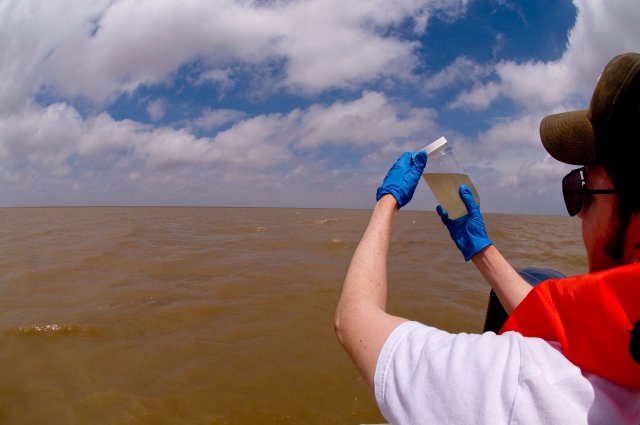Modeling the Links Between Discharge and Nutrients from the Mississippi River Basin to the Gulf of Mexico Hypoxia

Publications
1. Carbon Dynamics on the Louisiana Continental Shelf and Cross-Shelf feeding of hypoxia (2015) - Using data from five late July shelf-wide cruises from 2006 to 2010, carbon and oxygen production were examined and net autotrophicareas of phytoplankton growth on the Louisiana shelf were identified.
2. Carbon dynamics and community production in the Mississippi River plume (2012) - Dissolved inorganic carbon, total alkalinity, pH, and dissolved oxygen were determined in the Mississippi River plume during five cruises conducted in the spring, summer, and fall.
3. Microbial respiration and ecoenzyme activity in sediments from the Gulf of Mexico hypoxic zone (2014) - Sediment chemistry, microbial respiration, and ecoenzyme activity were measured in four zones of similarity in the northern Gulf of Mexico.
4. Microphytobenthos production potential and contribution to bottom layer oxygen dynamics on the inner Louisiana continental shelf (2014) - To investigate the relative importance of microphytobenthos (MPB) oxygen production on a river-dominated shelf, sediment core incubation measurements of MPB O2 production and sediment oxygen consumption were compared to water-column measures of primary production and respiration during one spring and two summer cruises.
5. Nutrient distributions, transports and budgets on the inner margin of a river-dominated continental shelf (2013) - Physical and biogeochemical processes determining the distribution, transport, and fate of nutrients delivered by the Mississippi and Atchafalaya river basin to the inner Louisiana continental shelf were examined using a three-dimensional hydrodynamic model and observations of hydrography, nutrients, and organic carbon collected during 12 cruises.
6. Plankton community respiration, net ecosystem metabolism, and oxygen dynamics on the Louisiana continental shelf: implications for hypoxia (2013) - A multi-year study was conducted of the Louisiana continental shelf to better understand the linkages between water column metabolism and the formation of hypoxia in the region.
7. Sediment-water fluxes of dissolved inorganic carbon, O2, nutrients, and N2 from the hypoxic region of the Louisiana continental shelf (2012) - One of the largest coastal hypoxic regions has been observed during the summer in the bottom-water of the Louisiana continental shelf. In this study, the sediment-water fluxes of dissolved inorganic carbon, oxygen, nutrients, and denitrification were measured on the Louisiana shelf during six cruises from 2005 to 2007.
